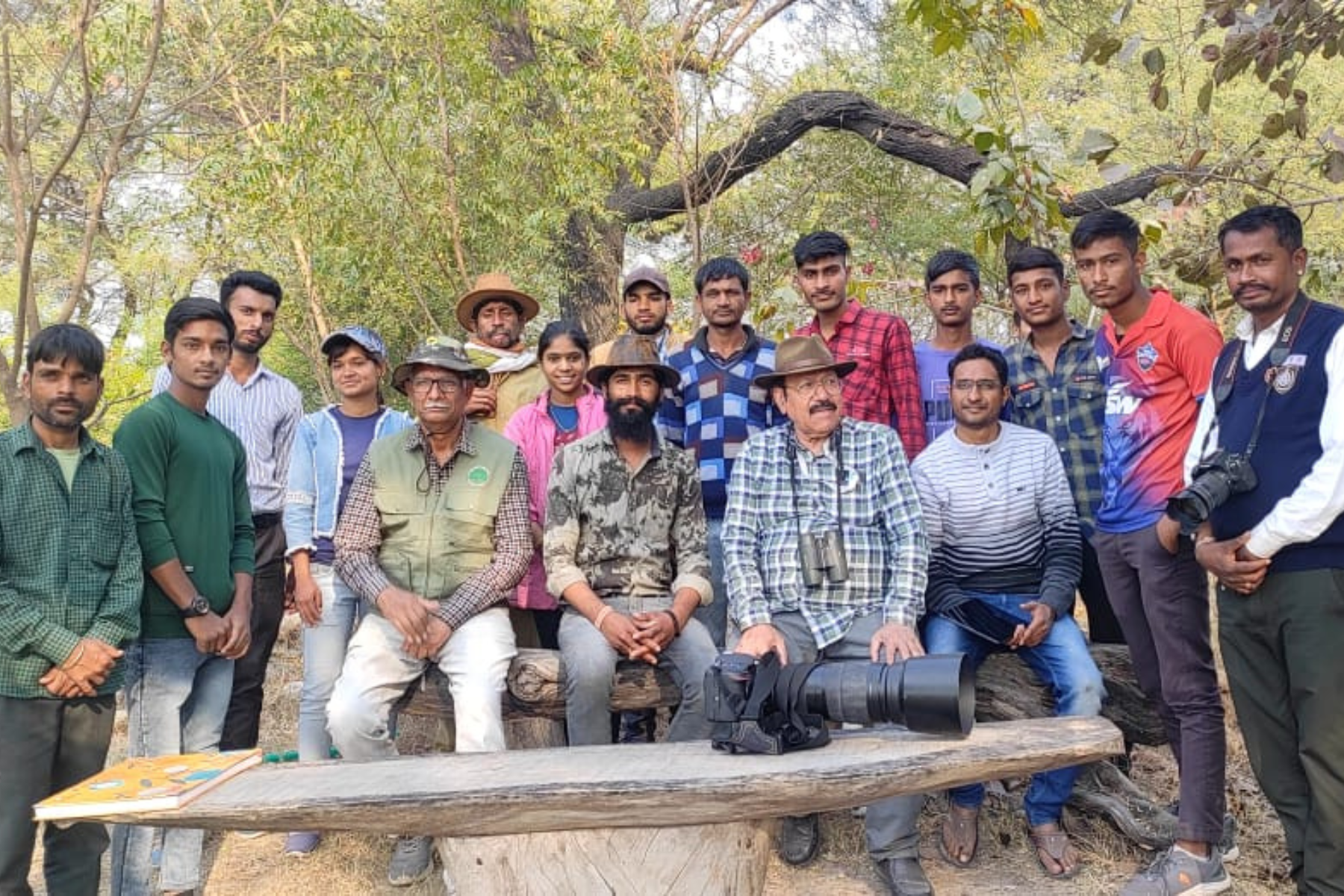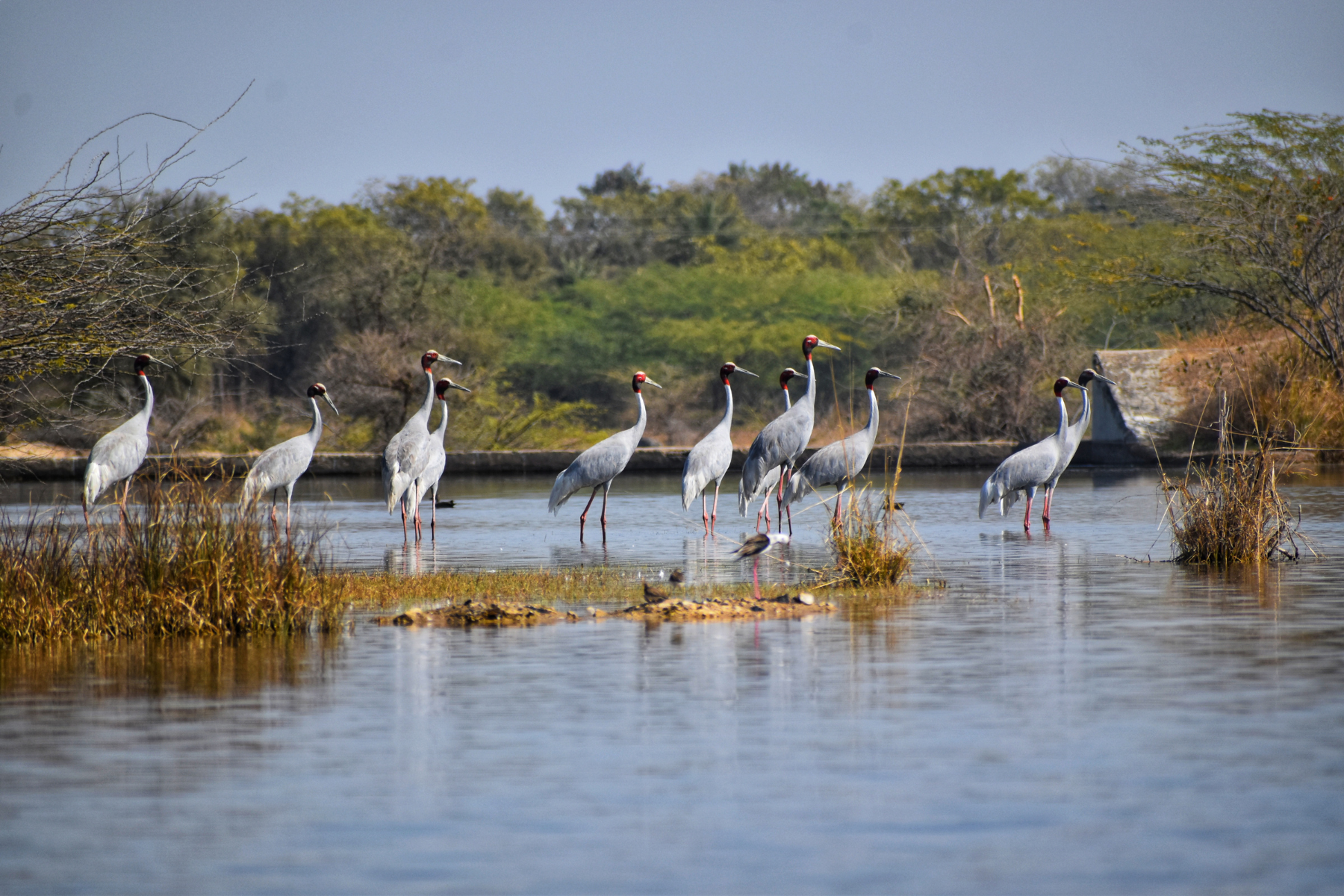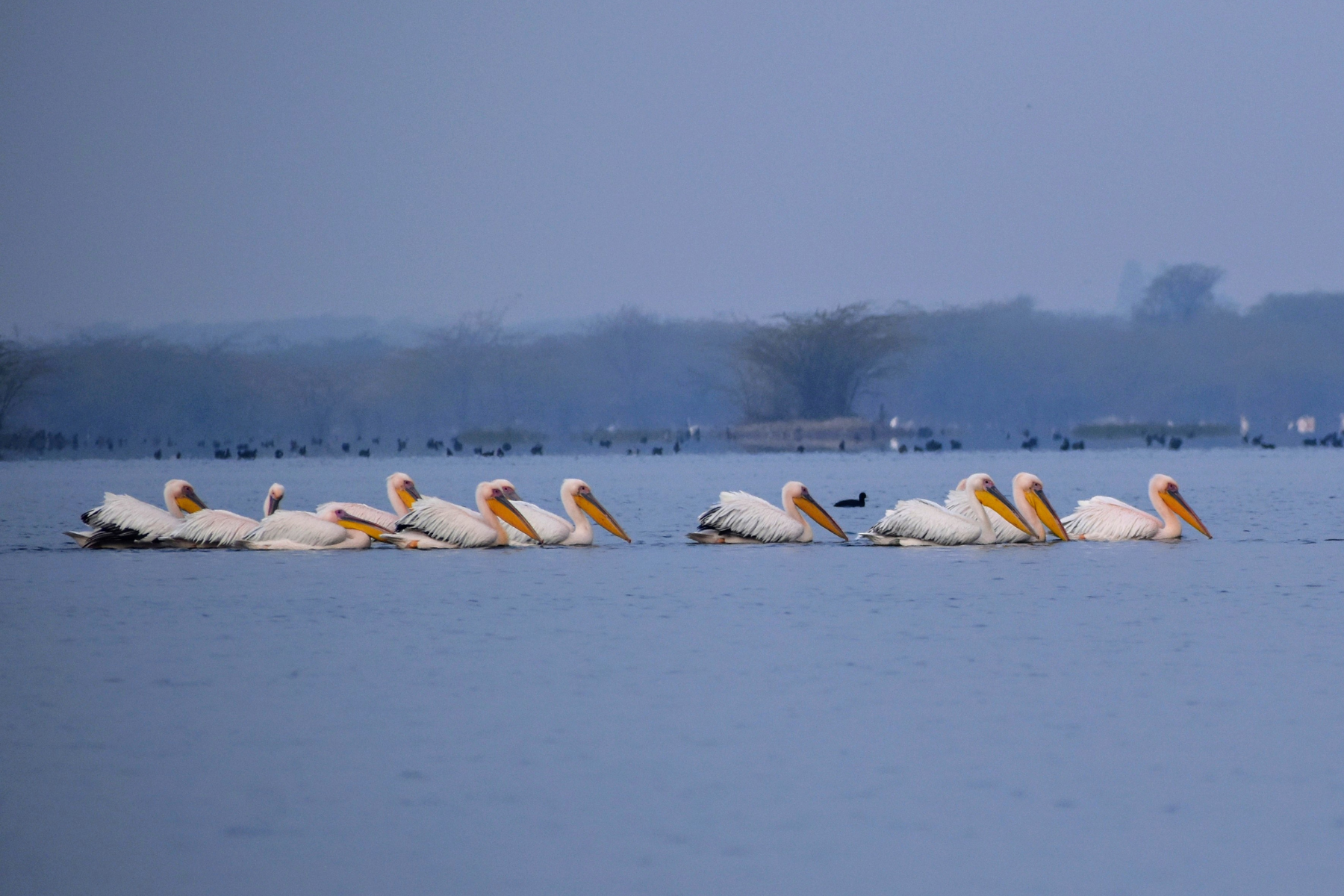The Bird Villages of Udaipur: Menar, Krishna Kareri and Badwai
First published in Sanctuary Asia,
Vol. 43
No. 8,
August 2023
By Asad Rahmani
My first visit to this birding haven was in 2014, during the first-ever Udaipur Bird Festival. The Menar wetland had always been zealously protected on religious grounds for hundreds of years. Shooting had been strictly prohibited by the village, and the birds here reflected that confidence, and were amazingly fearless, almost tame. The local people stand as a bulwark against poachers and trappers. Migratory birds that otherwise fly or move away from human beings at the slightest disturbance can be found feeding less than 15 m. away. Based on the number and diversity of birds visiting the wetland, Menar was added to our list of Important Bird and Biodiversity Areas (IBAs) in the revised edition of my book of the same name, published in 2016.
I also visited two other wetlands during that visit – Krishna Kareri and Badwai. These have received a conservation boost over the last decade with bird festivals organised by the Forest Department. When local people observed first-hand the enthusiasm of birdwatchers and support from the Forest Department, it encouraged them to provide better protection to their village wetlands. All three wetlands today are among the finest examples of community conservation in India.
Neighbour’s Envy, Owner’s Pride
Located by the Udaipur-Chittorgarh highway (NH-76), the Menar wetland is easily accessible. When the youth of Krishna Kareri and Badwai saw how the spotlight on Menar benefitted locals, they decided to showcase their wetlands too, both equally delightful avian magnets. Enthusiasm, conservation awareness, Mewari pride, and support of the Forest Department (particularly Dr. N. C. Jain, Rahul Bhatnagar, Dr. Satish Kumar Sharma, and Suhel Majboor), played an important role in rejuvenating these wetlands. There is now even a WhatsApp group called ‘Pakshi Vihar – Krishna Kareri’, maintained by local youth that send daily updates on wetland birds. I have watched, with great joy, the transformation of young people such as Bheru Lal Purohit of Krishna Kareri over the last nine years. From a callow young man in 2014, he is now an expert birdwatcher, communicator, and popular leader. Bheru now has a team of nearly 50 young girls and boys, trained with a smattering of bird knowledge, who guide visitors around the wetland. A steady stream of officials and birdwatchers have resulted in better facilities and cleanliness in the village. Government babus began paying attention to this area when they found their bosses visiting this nondescriptive village. Such is the strength of birdwatching.

Dr. Satish Sharma, Bheru Lal, Asad Rahmani and Ajay Kumar Menaria with volunteers committed to safeguarding the Krishna Kareri wetland that has been rejuvenated with the Forest Department’s support. Several youth living near this wetland have been inspired by the power and joy of birdwatching and are training to be nature guides ín the future. Photo: Umesh Menaria.
Another small wetland is Badwai on Udaipur-Pratapgarh road. A shallow habitat of 93 acres, it attracts thousands of waterfowl, including up to 300 Barheaded Geese. In the deadly summer heat, water dries up except in small pools, but the monsoon revitalises the wetland. Good water quality and a profusion of submerged vegetation provides plentiful food, which attracts waterfowl including Northern Pintails, Northern Shovelers, Common Teal, Gadwall, Spot-billed Duck, Common Coot, waders, and more. Diving ducks are fewer in number as the water is quite shallow. On three sides, the Badwai wetland is surrounded by agricultural fields that form the water catchment of the lake. A majestic old ficus tree near a temple provides shade to travellers, pilgrims, and birdwatchers in need of a break.
Another young man, Bherulal Shrimali with a Bachelor’s degree in mathematics, is active in protecting the Badwai wetland, along with a team of 10 volunteers. Some years ago, trapping and hunting occurred periodically, but now no hunter dares to visit Badwai with ill intentions – or guns! The local Panchayat is also supportive, and even bears the cost of pumping water into the wetland in summer. Such small gestures of ownership and acceptance by locals can be a gamechanger in conservation.

A flock of Sarus Cranes Grus antigone in the Menar wetland, which supports a healthy array of aquatic plants that provide food and shelter to migrant and resident avians. Photo: Umesh Menaria.
Wetland Diversity
Of the three wetlands, the best known is Menar. A large Shiv sculpture on the bund benignly overlooks the village and the Brahm Talab (lake). A twokilometre earthen bund retains the rain water. It has a large catchment area that extends across several kilometres during the monsoon. Another wetland, Dhand Talab, is just as bird-rich. Both talabs are situated on the outskirts of Menar village. Fortunately, the water quality is still good, with excellent growth of aquatic plants including Hydrilla verticillata, Ceratophyllum demersum, Vallisneria spiralis, Potamogeton crispus, Azolla pinnata, Ipomoea aquatica, Trapa natans, Spirodela polyrhiza, Wolffia arrhiza, which provide food and shelter to the avians. The lake margins are fringed by Typha angustifolia, Scirpus littoralis, and Ipomoea carnea. Thick growth of I. carnea is present along the pond edges. Patches of Typha angustata, Scirpus littoralis, and other Scirpus species are scattered in the shallow waters. On the bund and in surrounding areas, thick growth of babool, Acacia nilotica, vilayati babool, Prosopis juliflora, mango, and neem, amidst a patchwork of agricultural fields, provide habitat to terrestrial birds, adding to the richness of Menar wetland.
In December and January, between 8,000 and 10,000 waterfowl can be found here. In a year, over 20,000 waterfowl visit this area, many using this wetland complex as a stopover site during their arduous migration. This is demonstrated by the sudden influx of birds for a few days, followed by a quick, sharp decline in their numbers. A detailed, long-term study is necessary to ascertain this observation. About 62 species of aquatic birds have been reported in the Menar’s wetlands. If terrestrial birds are included, the total is close to 100 species. Among them, Knob-billed or Comb Duck, Cotton Pygmygoose, Indian Spot-billed Duck, and Lesser Whistling-duck are residents. The Great Crested Grebe has been observed breeding in Menar. The White-naped Tit, designated Vulnerable by the IUCN, has been reported in the thickets of Acacia nilotica on the banks of the lake. The Eurasian Bittern has also been recorded in Menar. Greater Flamingos too brighten the wetland during their short visit, as do Common Cranes in winter.

A Dalmatian Pelican Pelecanus crispus flock in the Menar wetland. Around 100 species of aquatic and terrestrial birds have been reported here. This wetland is among the finest examples of community conservation in India. Photo: Umesh Menaria.
The Future is Here
The debate between ‘community conservation’ and ‘fortress conservation’ has often split conservationists worldwide. Both groups are well-meaning, and present good case to support their point of view. Community conservation requires the involvement of locals in conservation programmes, with accrued benefits shared with the community. Meanwhile, fortress conservation protects ecosystems by isolating them from the community. I take a middle path, and support both approaches on a case-by-case basis. For many species such as the tiger, rhino, panda, Bengal Florican, Black-breasted Parrotbill, and the like, fortress-like strict protection of habitats in the form of boundary-delimited Protected Areas with minimum human presence is essential. For other species, particularly those living in large landscapes, or moving over large areas, such as migratory birds or elephants, community conservation plays a crucial role.
Hukka-Paani Bund
An interesting story connected to Menar village showcases the villagers’ fierce loyalty to their traditions and birds. In the days of yore, it was customary to provide food and water to travellers. On March 6, 1832, a British man John Teltson arrived from Udaipur with his staff, and camped near the Menar wetland. When he saw thousands of birds, he shot one for breakfast. He wrote that with the gun fire, birds rose like a cloud and darkened the sky. The alert villagers gave him a stern warning to not kill birds, and demanded he shift out of the village. The arrogant Englishman claimed that he had permission from the Maharana, but the resolute villagers forced him to flee with his 50 camp staff. No food or water was provided to them. In Hindi, we call this a ‘hukka-paani bund’. The story still resonates in Menar.
Over the last 10-12 years, I have developed an affinity for Menar and other wetlands, and the wonderful people who are protecting their liquid treasure. Not only wild birds, but cattle too are allowed to use the water to drinking and wallow. Thanks to the Menar wetlands, the local water table is high and bore wells are used for drinking water. Each person in the village ensures that no waste contaminates the pond, and all community toilets are located downstream of the catchment area of the wetlands.
I recently read that in the Kukurmara village in distant West Kamrup division in Assam, villagers were involved in caring for an injured female elephant. Despite the fact that villagers regularly suffer from wild elephant attacks, they came forward to feed a helpless creature. From the wetlands of Udaipur, where young people are carrying forward the tradition of animal protection, to Assam, where villagers value a wild elephant’s life, this is the real India, one that should fill us with pride.
Asad Rahmani, Director of BNHS (1997-2015), has authored several books, scientific papers and articles. His main interest is in grassland and wetland birds. He was also the Executive Editor of Journal of BNHS, and other BNHS publications.

.png)


